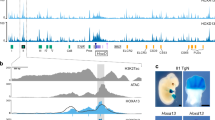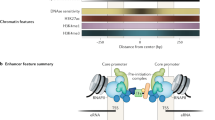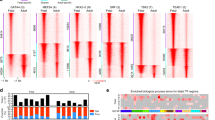Abstract
A REGULATORY element upstream of the human myoglobin gene functions as a muscle-specific enhancer (MSE) in conjunction with core promoter elements of the myoglobin gene, but not in combination with the simian virus 40 (SV40) early promoter1. These two promoters differ in the sequences of their 'TATA boxes': for the myoglobin gene, the sequence is TATAAAA (ref. 2), whereas for SV40, the sequence is TATTTAT (ref. 3). We have now tested the hypothesis that this sequence difference is responsible for the differential response of the promoters to the MSE. We found that when the TATA box sequence of the myoglobin promoter was changed to that of the SV40 promoter, responsiveness to the MSE was abolished; conversely, when the SV40 TATA box sequence was changed to that of the myoglobin promoter, the promoter became responsive to the MSE. We conclude that mammalian TATA-box elements are functionally heterogeneous, and suggest that this heterogeneity reflects differential interactions with distinctive TATA box-binding factors, only some of which can act cooperatively with MSE-binding proteins to generate an active transcriptional complex.
This is a preview of subscription content, access via your institution
Access options
Subscribe to this journal
Receive 51 print issues and online access
$199.00 per year
only $3.90 per issue
Buy this article
- Purchase on Springer Link
- Instant access to full article PDF
Prices may be subject to local taxes which are calculated during checkout
Similar content being viewed by others
References
Devlin, B. H., Wefald, F. C., Kraus, W. E., Bernard, T. S. & Williams, R. S. J. biol. Chem. 264, 13896–13901 (1989).
Weller, P., Jeffreys, A. J., Wilson, V. & Blanchetot, A. EMBO J. 3, 439–446 (1984).
Laimins, L. A., Khoury, G., Gorman, C., Howard, B. & Gruss, P. Proc. natn. Acad. Sci. U.S.A. 79, 6453–6457 (1982).
Sternberg, E. A. et al. Molec. cell. biol. 8, 2896–2909 (1988).
Jaynes, J. B., Johnson, J. E., Buskin, J. N., Gartside, C. L. & Hauschka S. D. Molec. cell. Biol. 8, 62–70 (1988).
Struhl, K. Molec. cell. Biol. 6, 3847–3853 (1986).
Chen, W. & Struhl, K. Proc. natn. Acad. Sci. U.S.A. 85, 2691–2695 (1988).
Harbury, P. A. B. & Struhl, K. Molec. cell. Biol. 9, 5298–5304 (1989).
Simon, M. C., Fisch, T. M., Benecke, B. J., Nevins, J. R. & Heintz, N. Cell 52 723–729 (1988).
Sawadogo, M. & Roeder, R. G. Cell 43, 165–175 (1985).
Huang, D.-H., Horikoshi, M. & Roeder, R. G. J. biol. Chem. 263, 12596–12601 (1988).
Horikoshi, M., Carey, M. F., Kakidani, H. & Roder, R. G. Cell 54, 655–669 (1988).
Horikoshi, M., Hai, T., Lin, Y.-S., Green, M. R. & Roeder, R. G. Cell 54, 1033–1042 (1988).
Nakamaye, K. I. & Eckstein, F. Nucleic Acids Res. 14, 9679–9698 (1986).
Author information
Authors and Affiliations
Rights and permissions
About this article
Cite this article
Wefald, F., Devlin, B. & Williams, R. Functional heterogeneity of mammalian TATA-box sequences revealed by interaction with a cell-specific enhancer. Nature 344, 260–262 (1990). https://doi.org/10.1038/344260a0
Received:
Accepted:
Issue Date:
DOI: https://doi.org/10.1038/344260a0
This article is cited by
-
Using Synthetic DNA Libraries to Investigate Chromatin and Gene Regulation
Chromosoma (2023)
-
CTGC motifs within the HIV core promoter specify Tat-responsive pre-initiation complexes
Retrovirology (2012)
-
Sp1-like proteins function in the transcription of human ferredoxin genes
Journal of Biomedical Science (2000)
-
Differentiation of neuroblastoma cells by phorbol esters and insulin-like growth factor 1 is associated with induction of retinoic acid receptor β gene expression
Oncogene (1999)
-
Sequences in the proximal 5′ flanking region of the rat neuron-specific enolase (NSE) gene are sufficient for cell type-specific reporter gene expression
Journal of Molecular Neuroscience (1997)
Comments
By submitting a comment you agree to abide by our Terms and Community Guidelines. If you find something abusive or that does not comply with our terms or guidelines please flag it as inappropriate.



